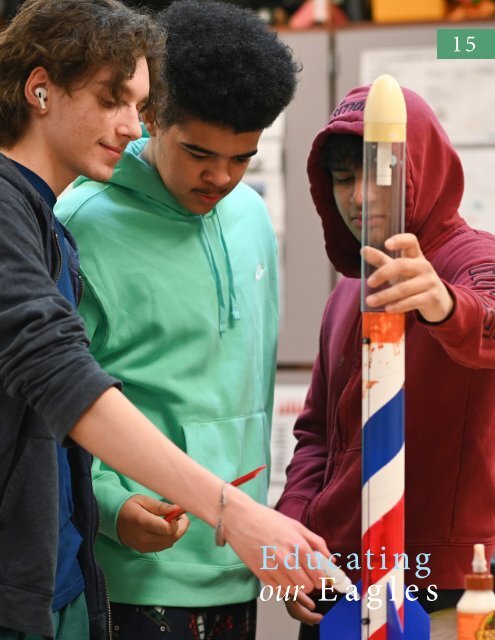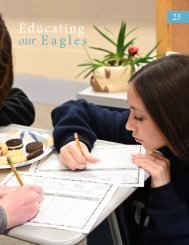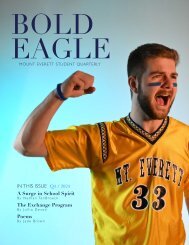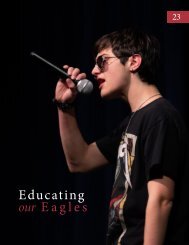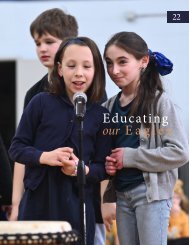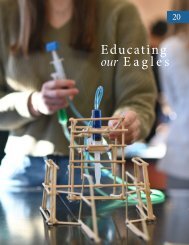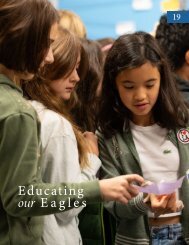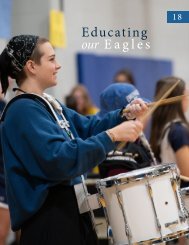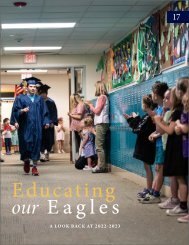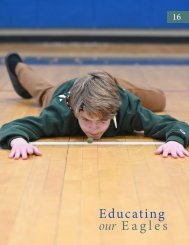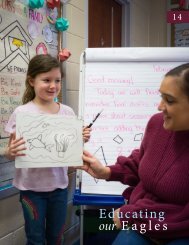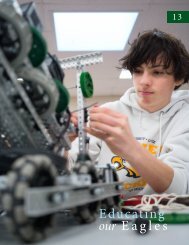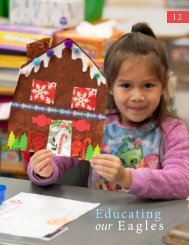You also want an ePaper? Increase the reach of your titles
YUMPU automatically turns print PDFs into web optimized ePapers that Google loves.
<strong>Educating</strong><br />
our <strong>Eagles</strong><br />
<strong>15</strong>
CONTENTS<br />
4<br />
Introduction - Curriculum Director, Julie Dolan<br />
6<br />
Kindergarten - Clay Sculptures – Kim Bleau<br />
8<br />
High School - Can Statistics be trusted? – Neal Barbieri<br />
10<br />
Second Grade - My Name is...Poem Project – Morgyn Gasperini<br />
12<br />
High School - Fitness Center – Josh King<br />
<strong>15</strong><br />
16<br />
17<br />
Middle School - March Madness College Research – Dawn Estes-Daub<br />
High School - Heredity, Inheritance and Variation of Traits – Tim Schwartz<br />
Middle/High School - Arts Department Connections – Kari Giordano<br />
Cover: High School students in Mr. Thompson's class work on their<br />
competitive rocket for The American Rocketry Challenge<br />
Right: Students in The Early College English course discuss W.E.B<br />
Dubois' novel, “The Soul of a Black Folk”.<br />
EDUCATING OUR EAGLES<br />
2
EDUCATING OUR EAGLES<br />
3
INTRODUCTION<br />
From SBRSD’s Director of Curriculum<br />
and Instruction, Julie Dolan<br />
Southern Berkshire Regional School District provides<br />
early literacy instruction that is rooted in evidence-based<br />
practices that include developing awareness of sound<br />
in spoken language, phonics and decoding instruction,<br />
building background knowledge, and developing reading<br />
fluency.<br />
We have been fortunate to have received several grants to<br />
support this work, and most recently we have been given<br />
funds to purchase new high quality instructional materials<br />
for our elementary schools. After a year-long, thorough<br />
investigation of several of the vetted and recommended<br />
curriculums, the teachers have selected a new program!<br />
Next steps are to complete the purchasing process and<br />
then plan and schedule professional development prior to<br />
the beginning of our next school year.<br />
If you would like to learn more about high quality literacy<br />
instruction, DESE (Department of Elementary and<br />
Secondary Education), has created a literacy resource for<br />
families.<br />
www.doe.mass.edu/massliteracy/families/default.html<br />
EDUCATING OUR EAGLES<br />
4
5
ELEMENTARY SCHOOL:<br />
Clay Sculptures<br />
The PreK class has been working on animal research as part of our Unit Three:<br />
Wind and Water. During this lesson we had the High School Art class come and<br />
work with students on making their animals out of clay. The clay was generously<br />
donated by Sheffield Pottery.<br />
As a result of instruction, students will be able to:<br />
• research and discuss a chosen animal.<br />
• describe their animal and show what their animal looks like.<br />
• practice creativity and craftsmanship while working with clay.<br />
• do their best to create their animal out of clay.<br />
Observations:<br />
It was really great having the high school art class here to help the students. The class<br />
worked well with the PreK. I think this is something we should do more often as it<br />
seemed like the older students enjoyed being here and working with the younger<br />
students.<br />
MA Standards:<br />
SL PK. 1-3<br />
L PK. 1<br />
L PK. 5,6<br />
W PK.2<br />
EDUCATING OUR EAGLES<br />
6
EDUCATING OUR EAGLES<br />
7
HIGH SCHOOL:<br />
Can Statistics be trusted?<br />
Everyday we are bombarded with data from polls and surveys. News programs<br />
consistently use statistics to inform their viewers. Can the data that is shown<br />
be trusted? Can data and statistics be manipulated to show what the researcher<br />
wants? These are questions that 12th grade math students in Mr. Barbieri's class<br />
set out to answer.<br />
As a result of instruction, students will be able to:<br />
• look at surveys, polls, graphs, etc. with a watchful eye.<br />
• critically think about the data and statistics they see and determine if polls and/or<br />
surveys are biased.<br />
Observations:<br />
Many students had never closely looked at the graphs, charts and survey results that they<br />
see in media. Students began to scrutinize, with a healthy dose of skepticism, results of<br />
some statistical correlations that were presented in class. They are now more data literate<br />
and understand how data can be manipulated and the ways you can break through the<br />
misconceptions.<br />
MA Standards:<br />
Interpreting Categorical and Quantitative Data AI.S-ID<br />
A. Summarize, represent, and interpret data on a single count or measurement variable. Use<br />
calculators, spreadsheets, and other technology as appropriate.<br />
Making Inferences and Justifying Conclusions AII.S-IC<br />
A. Understand and evaluate random processes underlying statistical experiments.<br />
B. Make inferences and justify conclusions from sample surveys, experiments, and observational<br />
studies.<br />
EDUCATING OUR EAGLES<br />
8
EDUCATING OUR EAGLES<br />
9
ELEMENTARY SCHOOL:<br />
My Name is... Poem Project<br />
<strong>Our</strong> second graders created beautiful Acrostic<br />
Poems using their names in response to the<br />
story, “My Name is Gabriela: The Life of<br />
Gabriela Mistral”. We read the story together<br />
on the first day and created a character trait<br />
web using descriptive adjectives to describe Gabriela.<br />
On the second day, the students brainstormed words<br />
and phrases they would use to describe themselves. After<br />
creating a rough draft of their poems, the students revised<br />
their work and drafted final copies. Along with their poems,<br />
the students had the opportunity to draw either a self<br />
portrait or a creative drawing. The poems are currently on<br />
display on our bulletin boards outside the second grade<br />
classrooms.<br />
As a result of instruction students will be able to:<br />
• use appropriate character traits to describe both story characters and themselves.<br />
• draft, revise and edit an acrostic poem using their name and descriptive adjectives.<br />
• produce a matching self portrait or creative drawing to go along with their poem.<br />
Observations:<br />
Students were enthusiastic, motivated throughout, and truly enjoyed this lesson. There was a little bit of<br />
hesitation while getting started, but once things got moving, you could see the students were having fun with<br />
it and playing around with different word options. Anytime we get to use what we have been learning about<br />
to create something is always satisfying for the students. It is also always fun to make something personal and<br />
feel a connection to the end result. Everyone likes to talk about themselves every once in a while. I noticed<br />
students loved walking around and complimenting each others drawings and poems. They said things like<br />
"Oh, I wish I thought of that word" or "Hey, that self portrait looks just like you". This group of students is<br />
super motivated and will not stop working until everything is up to their high standards.<br />
MA Standards:<br />
W.2.3<br />
RL.2.10<br />
RL.2.6
EDUCATING OUR EAGLES<br />
11
MIDDLE/HIGH SCHOOL:<br />
Fitness Center<br />
The Physical Education/Wellness department recently purchased fitness equipment to update<br />
our current Fitness Center. We spend at least 1-2 weeks a month in the Fitness Center with all<br />
of our Wellness Classes (Wellness 6, 7, 8, I & II) and offer fitness based classes in Advanced<br />
Sports Skills and Lifetime Fitness. The overall goal of our sessions in the Fitness Center is to have<br />
students gain access and knowledge of the benefits of fitness and the positive effects of being healthy<br />
and active.<br />
As a result of instruction, students will be able to:<br />
• understand basic functions of muscles and how to properly strengthen or train them.<br />
• learn the proper safety protocols of the fitness center and how to maintain proper etiquette<br />
while working out.<br />
Observations:<br />
A lot of our students really enjoy being in the Fitness Center and with the addition of our new<br />
equipment have found more initiatives to be healthier. Students sometimes can seem lost at first with<br />
what goes on in a Fitness room but once we teach them about muscle groups and find their passions<br />
and interests for working out a light bulb goes off. It is a pretty rewarding experience to see students<br />
gain interest in lifetime activities and fitness.<br />
MA Standards:<br />
2.4 Identify physical and psychological changes that result from participation in a variety of physical<br />
activities<br />
2.5 Explain the benefits of physical fitness to good health and increased active lifestyle.<br />
2.11 Apply basic principles of training and appropriate guidelines of exercise to improve immediate<br />
and long-term physical fitness. Students select an exercise related to one component of physical<br />
fitness (such as using proper sit-ups to increase endurance and strength of abdominal muscles,<br />
swimming laps to increase cardiorespiratory endurance). Record and graph the progress made over<br />
six weeks.<br />
2.12 Participate in activities that promote physical fitness, decrease sedentary lifestyle, and relieve<br />
mental and emotional tension.<br />
2.13 Explain the personal benefits of making positive health decisions and monitor progress towards<br />
personal wellness<br />
EDUCATING OUR EAGLES<br />
12
EDUCATING OUR EAGLES<br />
13
HIGH SCHOOL:<br />
Student Leadership<br />
To review skills for the upcoming AP English Language examination, practice public<br />
speaking, hone leadership, and cover a wide range of American nonfiction from 1880 to<br />
1930, juniors and seniors were responsible for selecting materials and preparing activities<br />
for thirty-minute lessons.<br />
Demonstrating an incredible breadth and depth of interests, students chose works<br />
by Elizabeth Cady Stanton, Andrew Carnegie, W.E.B. DuBois, Helen Keller, Lincoln<br />
Steffens, Booker T. Washington, and Virginia Woolf, among others. Their lessons included full class<br />
conversations, small "cocktail party" exchanges, "speed dating" Q&As, competitions, and an array of<br />
original focused writing prompts. Following their leadership, each student composed an extensive<br />
reflection of their experience, successes, and future targets.<br />
Heading into their thirty-minute sessions, students knew that they were fully able to<br />
• select and develop appropriate and challenging materials;<br />
• prepare questions, activities, and writing to foster rigorous analysis;<br />
• facilitate subtextual and issue-based discussions; and,<br />
• demonstrate flexible yet targeted speaking and listening skills.<br />
Observations:<br />
Despite the daunting task of leading peers, everyone rose to the occasion, left their comfort zones, and created<br />
truly unique learning opportunities. Some students tried a more regimented top-down approach, while others<br />
opted for a milder direct-and-release strategy. All brought forward their strong insights and appreciation for<br />
writerly choices and the consequent impact. Observing from the back of the classroom, I was impressed and<br />
delighted by their maturity, capacity, humor, and growth ... and found myself taking notes on their methods<br />
that I'd like to add to my repertoire!<br />
MA Standards:<br />
Two-thirds of the way through the academic year, "Student Leadership" was a way for students to demonstrate gains across two<br />
concentrations of the "Massachusetts Frameworks":<br />
Grades 11-12 Reading Standards for Informational Text<br />
RI-1: Cite strong and thorough textual evidence to support analysis of what a text states explicitly as well as inferences drawn from the text.<br />
RI-2: Determine two or more central ideas of a text and analyze their development over the course of the text, including how they<br />
interact and build on one another to provide a complex analysis.<br />
RI-4: Determine the meaning(s) of words and phrases as they are used in a text, including figurative, connotative, and technical<br />
meanings.<br />
RI-5: Analyze and evaluate the effectiveness of the structure an author uses in an exposition or argument, including whether the<br />
structure makes points clear, coherent, convincing, and engaging.<br />
RI-8: Delineate and evaluate the reasoning in seminal historical texts.<br />
RI-10: Independently and proficiently read and comprehend literary nonfiction representing a variety of genres, cultures, and<br />
perspectives and exhibiting complexity appropriate for the grade/course.<br />
Grades 11-12 Speaking and Listening Standards<br />
SL-1: Initiate and participate effectively in a range of collaborative discussions.<br />
SL-3: Evaluate a speaker’s point of view, reasoning, and use of evidence and rhetoric, assessing the stance, premises, links among<br />
ideas, word choice, points of emphasis, and tone used.<br />
SL-4: Present information, findings, and supporting evidence, conveying a clear and distinct perspective.<br />
SL-6: Adapt speech to a variety of contexts and tasks, demonstrating a command of formal English when indicated or appropriate.
EDUCATING OUR EAGLES<br />
<strong>15</strong>
MIDDLE SCHOOL:<br />
March Madness College Research Project<br />
The entire 8th grade participated in a college exploration activity. Students randomly drew<br />
colleges and universities that were participating in the NCAA basketball tournament. They then<br />
had to research their school. Using various resources, students identified the school's location,<br />
enrollment, popular majors, acceptance rate, cost of attendance, team mascot and notable<br />
alumni. The activity culminated in a poster presentation.<br />
As a result of instruction, students will be able to:<br />
• Demonstrate familiarity with a college or university.<br />
Observations:<br />
Students enjoyed the connection to the basketball tournament. They liked learning about schools that are<br />
located in different parts of the country.<br />
MA Standards:<br />
4.C.04.07 See projects through completion and check work for quality and accuracy.
HIGH SCHOOL:<br />
Heredity, Inheritance and Variation of Traits<br />
N<br />
inth grade Biology Students are completing their genetic studies involving incomplete<br />
dominance, codominance, and sex-linked traits. Honors biology students are exploring the<br />
role of natural selection in speciation.<br />
As a result of instruction, students will be able to:<br />
• complete a Punnett Square and identify probability of certain genetic mutations.<br />
Observations:<br />
Students worked well in a group setting and were able to correct each others' work. Giving them the ability to<br />
explain to each other was very rewarding.<br />
MA Standards:<br />
HS-LS3-3<br />
EDUCATING OUR EAGLES<br />
17
MIDDLE SCHOOL:<br />
Fine and Performing Arts Department<br />
W<br />
hile it is common to assess a student's learning based on the final product, be<br />
it a piece of fine art or a performance, much of the success of student learning<br />
happens during the process. The educational model of learning by doing is<br />
nowhere better exemplified than in arts education and Mount Everett's Visual<br />
and Performing Arts Department embraces this philosophy.<br />
Performance in the arts involves a complex layering and interrelationship of knowledge,<br />
understanding, and interpretation. In the Arts, students not only learn the rules and language<br />
of their medium, but also the habits of mind, imagination, discipline and critical thinking to<br />
continuing to work through roadblocks and solve problems. For every performance, countless<br />
hours of rehearsals were preceded by foundational preparation in class, working with teachers,<br />
family and peers, and through individual reflection and growth. We are always so proud to see<br />
our performing students on stage and the work of our visual artists displayed in the hallways or in<br />
museums around Berkshire County. With this in mind, we honor our artists and value the hard<br />
work that they put into their studies throughout the year, each day.<br />
This month, the Arts Department offered a chance for students to collaborate across disciplines.<br />
Students in Graphic Design One and Digital Design and Marketing created poster designs to be<br />
used for the Spring production of Rogers and Hammerstein's Cinderella. Students learned the<br />
basics of typography, composition, layout design and industry-standard editing software found in<br />
the Adobe Creative Cloud to produce their own versions of a successful production poster. These<br />
beginner designers had the opportunity to create real-world, applicable design as they were going<br />
through their foundational learning. Paired with the tremendous efforts of the cast and crew of<br />
Cinderella, this collaboration really exemplified the philosophy of the Arts Department at Mount<br />
Everett. Every SBRSD student has the opportunity to have their lives enriched by the arts – in<br />
our classrooms and on our stages. Through these experiences, our students learn by doing each<br />
day. Whether they decide to pursue the arts as a career or simply enjoy the creative presence in<br />
their lives, we can not be more proud of their efforts.<br />
<br />
<br />
Mount Everett Regional School Theatre Department welcomes you to RODGERS & HAMMERSTEIN'S<br />
Cinderella<br />
<br />
Friday, March 24- 7pm<br />
Saturday, March 25 - 7pm<br />
Sunday, March 26 - 2pm<br />
<br />
<br />
<br />
Friday, March 24 - 7pm<br />
Saturday, March 25 - 7pm<br />
Sunday, March 26 - 2pm<br />
At the Thomas A. Consolati Performing Art Center<br />
Tickets at the Door<br />
$8 for Students<br />
$10 for Adults<br />
<br />
<br />
<br />
RODGERS & HAMMERSTEIN'S CINDERELLA: YOUTH EDITION is presented by arrangement with Concord<br />
Theatricals on behalf of The Rodgers & Hammerstein Organization. www.concordtheatricals.com
EDUCATING OUR EAGLES<br />
19
EDUCATING OUR EAGLES<br />
20


